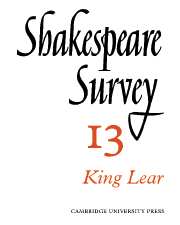Book contents
- Frontmatter
- The Catharsis of King Lear
- Lear’s Last Speech
- Albany
- Madness in King Lear
- The Influence of Gorboduc on King Lear
- Some Aspects of the Style of King Lear
- Keats and King Lear
- King Lear on the Stage: A Producer’s Reflections
- Costume in King Lear
- The Marriage-Contracts in Measure for Measure
- Tom Skelton—A Seventeenth-century Jester
- Illustrations of Social Life III: Street-Cries
- An Elizabethan Stage Drawing?
- Was there a Music-room in Shakespeare’s Globe?
- International Notes
- Shakespeare Productions in the United Kingdom: 1958
- Three Adaptations
- The Year's Contributions to Shakespearian Study 1 Critical Studies
- 2 Shakespeare’s Life, Times and Stage
- 3 Textual Studies
- Books Received
- Index
- Plate Section
Some Aspects of the Style of King Lear
Published online by Cambridge University Press: 28 March 2007
- Frontmatter
- The Catharsis of King Lear
- Lear’s Last Speech
- Albany
- Madness in King Lear
- The Influence of Gorboduc on King Lear
- Some Aspects of the Style of King Lear
- Keats and King Lear
- King Lear on the Stage: A Producer’s Reflections
- Costume in King Lear
- The Marriage-Contracts in Measure for Measure
- Tom Skelton—A Seventeenth-century Jester
- Illustrations of Social Life III: Street-Cries
- An Elizabethan Stage Drawing?
- Was there a Music-room in Shakespeare’s Globe?
- International Notes
- Shakespeare Productions in the United Kingdom: 1958
- Three Adaptations
- The Year's Contributions to Shakespearian Study 1 Critical Studies
- 2 Shakespeare’s Life, Times and Stage
- 3 Textual Studies
- Books Received
- Index
- Plate Section
Summary
Perhaps one reason why King Lear has been mistaken for an unactable play is that it is so nearly an unreadable play: taken passage by passage, it is so flat and grey that the better one knows it the more one feels on reopening its pages that this is almost (as Byron said of Caractacus) ‘a tragedy complete in all but words’; the style alone might lead one to suppose that what happens in King Lear happens in some realm of the imagination beyond ear and eye. This cannot be true, but how is the difficulty of the language to be resolved? The apocalyptic sublime in Lear’s defiance of the storm, however much it sticks in the memory, is not the play’s climax, nor does this style continue. What of the rest? The ‘simplicity’ of the closing scenes has been remarked, as has the effective contrast with Lear’s former pretensions, but in remarking this we tend to look through the language to what it is ‘about’, commending it only for transparency and truth to nature, and though we know that such scenes are not to be had by taking a tape-recorder to a deathbed, the terms in which to discuss this style have eluded us. It has been suggested that its art is to be discerned by tracing thematic patterns that give density or bite, but this explanation is vitiated by the fact that other plays by Shakespeare are said to have it too; the case has not been argued that the absence from Lear of resplendent imagery, idiosyncrasy of mind expressed in mannered style, indeed of poetry that survives quotation out of context, is deliberately compensated for by an unusually high charge of thematic power. Moreover the suggestion that the play’s language draws its power from a sustained thematic undercurrent conflicts with one’s obscure sense that what is really peculiar about the language is the freedom and unexpectedness of its melodic line; Lear himself is unfailingly astonishing, and this property of his words is resistant to explanation in terms of the recurrence of patterns, though, perhaps, in order to maintain this astonishment without having the play fall to bits, Shakespeare might find himself compelled to labour in the vocabulary towards the minimum number and maximum generality of moral and philosophical concepts.
- Type
- Chapter
- Information
- Shakespeare Survey , pp. 49 - 57Publisher: Cambridge University PressPrint publication year: 1960

